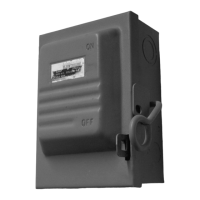to 2167°F as you had programmed. Skip to the next seg
-
ment, which is a slow cooling one. If the firing does not in
-
clude a slow cooling segment, and you are in the last seg
-
ment, Skip Segment will not end a Hold. Press the
Start/Stop key to end the firing.
Pointer: Make a note of the temperature at which
the cone bent. Program that temperature for the
next firing. This is the type of information that
should be recorded in a kiln firing log book if you
have one.
You can see the segments in the Cone-Fire firing sched
-
ules on pages 30-31.
The
[SKIP] option does not skip from a ramp to a hold
of the same segment. It skips to the next segment from ei
-
ther a ramp or hold of the current segment.
If the current segment has already started its hold time,
you can edit only the hold time. See below.
Note: If you wait 60 seconds without touching a key
during editing, the controller will exit editing with
-
out changing the settings. The firing will continue.
Skip to the Next Segment
1 During a Cone-Fire or Ramp-Hold firing, press
the Up Arrow.
[SKIP] will appear.
2 To skip to another segment, press Start/Stop.
The next segment will appear. Each time you press
the Up Arrow, another segment will appear, if an-
other has been programmed, followed by CANC
(Cancel).
3 Press the Up Arrow until the segment that you
want to skip to appears. Press Start/Stop. The
kiln will continue to fire in the segment you se-
lected.
4 If you don’t want to skip to another segment after
all, press the Up Arrow until CANC appears.
Then press Start/Stop. The kiln will continue to
fire as before.
Change the Hold Time of the Current Segment
1 During a Cone-Fire or Ramp-Hold firing, press
the Up Arrow twice.
[HLDT] (Hold Time) will ap
-
pear.
2 To change the hold time of the current segment,
press Start/Stop.
3 Use the arrow keys to change the hold time. Each
time you press an arrow key, the hold time will in
-
crease or decrease by 5 minutes.Then press
Start/Stop. (If you don’t want to change the hold
time after all, leave the setting alone and press
Start/Stop.)
Change the Target Temperature
of the Current Segment
1 During a Cone-Fire or Ramp-Hold firing, press
the Up Arrow 3 times.
[CHGT] (change tempera
-
ture) will appear. Press Start/Stop.
2 Use the arrow keys to change the temperature.
Then press Start/Stop.
Cone-Fire Options
These options appear only if a Cone-Fire program has
been selected. If your controller doesn’t have Cone-Fire
mode, skip to General Options, next page.
OFST / Cone Offset
Calibrate Cone-Fire to a Witness Cone
Sometimes the pyrometric cones programmed in
Cone-Fire do not match the bending of the witness cones.
Cone Offset will adjust Cone-Fire to bend the cones.
Note: TCOS, Thermocouple Offset, page 20, ad
-
justs all temperature readings. Cone Offset
changes only the last heating segment of all the
Cone-Fire firings. You can see the Cone-Fire
schedules on pages 30-31.
Follow these guidelines before deciding to use Cone
Offset:
I
The thermocouple (temperature sensor) must protrude
into the firing chamber the correct distance: about ¾”
for ¼” wide thermocouples, ½” - 5/8” for 1/8” wide
thermocouples.
I
Keep shelves 1”-1½”away from the thermocouple.
I
Keep pyrometric witness cones at least 2” away from
heating elements.
I
Place witness cones in several locations in the kiln.
How to Use Cone Offset
Cone Offset changes the shut-off point of the cone by the
degrees of temperature shown in the chart, next page.
1 First, program a Cone-Fire. See page 10.
2 From [IDLE] , press the Up Arrow repeatedly un
-
til
[OFST] appears.
Note: With each Up Arrow key press, you will see
the next option. When you see
[EXIT], press the
Up Arrow again to see more options. When
[OPT2] appears, press Start/Stop. That will take
you to more options.
3 When you see [OFST] press the Start/Stop key.
The current Cone Offset adjustment number will
appear.
4 Using the arrow keys, select a new adjustment
number (see chart, next column). Then press the
Start/Stop key.
[IDLE] will appear.
Sentry Xpress 5 Cone-Fire / Ramp-Hold
16 Do not leave your kiln unattended during operation.

